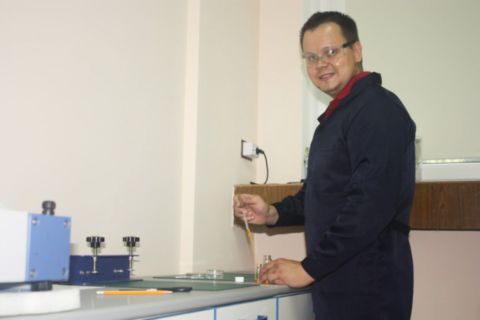Scientists from South Ural State University have obtained asymmetric molecules of a new type for the first time in world practice. These can glow in a wide spectral range: from visible to infrared spectrum. The new substances do not yet have a name. They are obtained synthetically from available organic compounds.
"To carry out the reaction, we needed a catalyst − palladium. As a result, asymmetric heterocyclic molecules, capable of either absorbing light or emitting it, were formed. Particular attention was paid to the C–H activation reaction, with the help of which promising light-emitting materials were synthesized," explains Timofei Chmovzh, Candidate of Sciences (Chemistry), Senior Research Fellow at the SUSU Nanotechnology Research and Education Centre.
The essence of the invention is to carry out a chemical reaction between two molecules, one of which contains a hydrogen atom, the other − a bromine atom. When they interact with each other and with the participation of palladium particles, new compounds, not existing in nature before, are formed.
The conditions for obtaining the acceptor compound were of particular difficulty. Scientists have found that high temperatures (over 100°C) are needed to introduce a bromine atom into a molecule. Another condition is carrying out the reaction in a hydrobromic acid medium. The chemical reaction itself lasts from 12 to 16 hours.
"The reaction is carried out in an insulated container in which a non-brominated substance and hydrobromic acid are placed. Then bromine is added dropwise into the container, and then the contents are mixed at 110°C at a strictly defined time. As a result of a chemical reaction, a bromine atom is incorporated into a molecule. This molecule is introduced into the C–H activation reaction with other compounds to form asymmetric derivatives that are capable of emitting light," says Timofei Chmovzh.
The substances created by the Chelyabinsk scientists are designed to produce OLED light-emitting devices that are used for lighting devices (lamps, displays for smartphones and digital cameras). They are fundamentally different from those that already exist on the market.
"Firstly, its cost is lower, because organic compounds are cheaper," explains Timofei Chmovzh. "But most importantly: the device will emit light that is favourable for the human body. Many competitors have light-emitting substances containing a blue component in their emission spectrum, which is harmful to the retina. In addition, our organic compounds do not contain heavy metal atoms."
The engineers have already tested the new technology in the laboratory: they applied their unique substance to a solid substrate and made sure that the device glows well. Now the main task is to test the invention at high power. The scientists intend to negotiate with large enterprises that produce LED-devices. It will take about a year to establish industrial production of safe LEDs in Russia.




